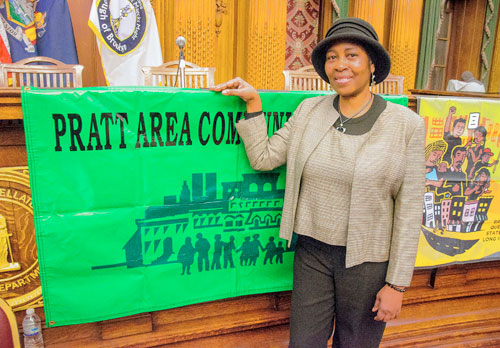Brooklyn’s long-troubled housing court is set to get a new home in Downtown’s Municipal Building, but not before suffering through five more years in its current crowded digs.
The city’s agreement to relocate the courthouse from its cramped quarters in an 18-story office building on Livingston Street at Smith Street a few blocks away to Joralemon Street drew cheers from tenant advocates, but one groaned that the halls of justice aren’t getting the custom building they require.
“It’s great that the city’s making plans to leave Livingston,” said Jenny Laurie, assistant director of Housing Court Answers, an organization that provides people with free legal help in housing cases. “But all of us were hoping there would be a new building that was designed to be a court.”
The city began leasing the current court space in 1983, and it is dingy, cramped, and not disabled-person accessible, advocates say.
“It’s just so bad there now,” said Delcina Biggs, a tenant organizer with the Pratt Area Community Council. “They’re not even real courtrooms.”
The city agrees that the Livingston Street building, which also contains civil and small-claims courts, is not suitable. Officials started scouting potential locations before the lease ran out earlier this year. A spokesman from the mayor’s office said the city settled on the Municipal Building after it proved difficult to find a landlord willing to rent to the city. Officials have a temporary agreement with the owner of the Livingston Street tower, David Bistricer, and plan to enter a five-year lease at a rate of $8.2 million per year.
Bistricer bought the building in 2002, and in 2010 found himself in the crosshairs of then-Public Advocate Bill DeBlasio, who listed Bistricer on his worst landlords list for the dire state of a 59-building housing development in East Flatbush that had racked up 6,475 building violations. DeBlasio called on then-Mayor Bloomberg and the Department of Citywide Administrative Services, which is in charge of city leasing, to pressure Bistricer to clean up his act.
The tycoon has since spent $20 million on repairs and whittled the number of violations down to 422.
The city paid Bistricer’s company Berkshire Equities $10.5 million in rent on the Livingston Street space and other properties last year, according to the comptroller’s office. The courts’ lease renewal requires Bistricer to add additional courtrooms on the ninth floor, and to repair elevators, heating, and cooling systems, per a spokesman for the mayor’s office. The lease is actually for 10 years with an option to terminate after the fifth.
The move will take five years to complete because city agencies currently operating in the Municipal Building have to be relocated before the new courts are built, and because changing the use of a city-owned property requires a formal land-use review procedure.
The city sold off the bottom two floors of the Municipal Building to Downtown real estate tycoon Al Laboz in 2011 for half their value. Laboz renovated and rented out the space to big-name retailers including Sephora, a makeup store, and Neiman Marcus, an upscale clothing chain.
After 31 years of substandard digs, housing advocates are asking the city to be cautious as they convert another office building into a courthouse. Biggs said she would wait to see how the finished product looks to render a judgement.
“It depends on how they fix it up,” she said. “They have their work cut out for them. We don’t need the same problems in a new building.”

























